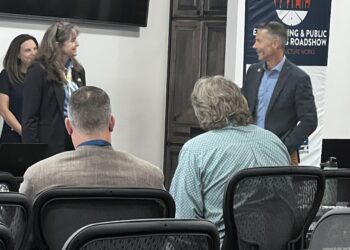OKLAHOMA CITY (OBV) – The Oklahoma Workforce Commission is ready to refocus Oklahoma’s workforce, and one commission member spoke with Oklahoma Business Voice about his enthusiasm to grow tomorrow’s workforce through educational initiatives that prepare students for their future careers.
Senate Bill 621, written by Sen. Adam Pugh, R-Edmond, and Rep. Brian Hill, R-Mustang, created the Oklahoma Workforce Commission, and Gov. Kevin Stitt signed it into law in June during a ceremony at the AAR Aircraft Services hangar at Will Rogers World Airport.
The Workforce Commission will work to coordinate the state’s workforce efforts. Their objective is to streamline workforce processes into a more efficient and effective system that will grow the economy and produce greater numbers of skilled workers.
Business leaders across Oklahoma say the shortage of skilled workers is their most pressing concern.
The State Chamber Research Foundation released the 2023 Business Leaders Poll this past summer. The poll is concerned with understanding the nature of workforce challenges Oklahoma businesses face. SCRF surveyed business leaders about struggles in filling skilled positions, workforce quality and availability concerns and the importance of education in growing the workforce.
Fifty percent of business leaders who participated in the poll said skilled, credentialed workers is the most difficult vacancy to fill. The need for more skilled experienced workers is also the primary reason most employers, 29 percent, do not rate the available workforce higher. This theme continues with 50 percent of business leaders saying finding employees with durable skills is their greatest concern when it comes to the available workforce.
Most business leaders, 49 percent, agree that Oklahoma’s education system must be more focused on providing students specialized skills that will meet workforce needs in the state.

Dirk O’Hara, Principal at Valir Health, is a member of the Workforce Commission. He also owns Norman Senior Care, and is president of the Norman Public Schools Board of Education. O’Hara said career-based education initiatives are key to growing the state’s workforce.
“I think that we have many opportunities to help all of our individuals, whether they’re young kids in education, primary, secondary education, or they’re people that want to retrain,” O’Hara said. “We have a huge opportunity to give them bigger and better opportunities to reach their dreams, to work where they want to work, and at the same time to recruit the right businesses and the right industry into the state with a workforce that’s educated and prepared for the field that they want to bring to Oklahoma.”
A greater effort must be made to help Oklahoma adolescents become more thoughtful about what they want their career to be, O’Hara said.
“There’s nothing wrong with talking to elementary school kids about what they want to be when they grow up in a more constructive way. And giving them the ideas and the thought processes and the tools to start to say, ‘What are they good at and what do they enjoy doing,'” O’Hara said. “That’s the main thing: What are you good at? What do you enjoy doing? And where do those two things intersect?’ That is now a career, but also a life you enjoy.”
Nurturing career consciousness is the first step. Then comes the planning.
“Then we have to flesh that out in middle school and high schools with a proper plan, a proper way for ‘if this is what you are good at and what you enjoy doing, what does that look like from a course selection? What does that look like from, “Do we need mentors? Do we need people to introduce you to the fields that you’re at?”‘ It’s a layer in an add on to what we’re already doing,” O’Hara said. “Most schools in Oklahoma are doing the best they that they can with the resources that they have. We have to find a way for schools to work together to create even more opportunities as far as courses, as far as opportunities, as far as new ideas for continuing to help all of our students think about what they’re going to be when they grow up.”
Education must be a focus of the Workforce Commission, O’Hara said.
“And that doesn’t necessarily mean primary and secondary [schools]. But if you’re going to have a workforce to meet where we are today for industry growth, for the changes that continue to happen and computers, I think we have to be educating everyone from our young kids to our middle aged people who need to be retrained and retooled for the workforce of tomorrow,” O’Hara said. “That all centers around education. Every aspect of having a world class workforce is education, and we call that sometimes training. What’s free education? Or what have we learned with our own companies that we have to be doing with our own workforces on a regular basis? It’s training. Training, training. And we as humans have to be embracing education and or training as part of our life forever.”
Oklahoma CareerTech’s presence is essential to the Workforce Commission’s efforts, O’Hara said. CareerTech oversees the states career and technology education programs, providing Oklahomans the training, vocational education and certifications they need to enter a wide range of careers.
“I absolutely think that they need to be at the table. They’ve been at the roundtable for many years and they work well with others,” O’Hara said. “As far as how do we use the resources we have to help train many, many, many careers and how do we flex, you look at more and more of them with what they’re doing with their mechanics for the aviation field and the amount of time, energy and effort they’ve put into that to help us grow in that area.”
Oklahoma CareerTech will be involved with the Oklahoma Workforce Commission since they will be helping with strategic solutions for growing the workforce, according to Hill.
“As someone who has toured half the campuses across the state, I’m very passionate about them,” Hill said. “I think their voice is in the part where the commission looks and hears from industry and what is actually needed by industry, and then connects it to CareerTech higher ed and those providers.”
O’Hara said it’s too early for him to say which workforce sectors need improvement, but he said more of certain important jobs are needed.
“I have no doubt that across all areas we can improve in Oklahoma. We know we can improve from an educational standpoint. We know we can improve from a training standpoint. And if you look at where we are from a health care standpoint, we need more nurses. From an education standpoint, we need more teachers and trainers. From a construction standpoint, we need more of all the trades. From a engineering standpoint, we need more STEM training. We need to hire more engineers from mechanical to electrical to chemical to all the above,” he said. “So, I don’t think there’s any shortage of opportunity for how we can continue to improve and give opportunities for training in education.”

It was a long road to get to reach the Workforce Commission
SB 621 was born from research which revealed a workforce deficiency in Oklahoma. A State Chamber and Business Roundtable joint survey found that 60 percent of Oklahoma’s business community said workforce shortages were the number one threat to business growth and expansion. Chad Warmington, president and CEO of The State Chamber of Oklahoma, and Ben Lepak, executive director of the State Chamber Research Foundation, provided Stitt and legislators research data which showed that Oklahoma was 36,000 workers deficient in filling available jobs.
It was determined that a new, focused workforce management system was needed to grow the state’s workforce and fill the thousands upon thousands of available jobs.
“What we learned very quickly was there’s a lot of good people in Oklahoma doing good work on workforce, but there was no collaboration or coordination between those entities,” Warmington said during the signing ceremony. “There was none. No one owner of workforce who at the end of the day, the governor and the legislature could point to and say, ‘Why do we have workforce shortages and what are we going to do to fix it?'”
The Oklahoma Workforce Commission will direct the state’s workforce development strategy and administer and oversee funding allocated by the legislature for workforce development initiatives. The commission can contract with outside parties to achieve its goals.
“How can we ensure across the entire enterprise of systems and agencies, and individuals and entities that build our workforce, how can we ensure we are creating men and women with the skillsets that they need – whether it be aerospace, engineering, biomanufacturing, agribusiness, healthcare, whatever jobs may exist for my five year old in 2040 that don’t even exist today – and who will be in charge of that?” Pugh said in February. “Senate Bill 621 seeks to provide that answer. And it will work with business leaders in the private sector, with education leaders and with government leaders to ensure that [state government leaders] are not the ones growing the economy, that we’re giving you all the tools you need to grow the economy.”
Pugh filed SB 621 in January, days after Stitt issued Executive Order 2023-02 to streamline and refocus the state’s workforce management process. The executive order called for the creation of a Workforce Transformation Task Force. Warmington and Oklahoma Commerce Secretary Chad Mariska co-chaired the task force, which was composed of private sector leaders and public officials. The task force identified how funding could be aligned with workforce goals and economic needs and implemented a comprehensive strategy that will change workforce for the better.
The Task Force concluded that Oklahoma needs a “single owner” of workforce development that serves as a statewide coordinating body for agencies and stakeholders involved in workforce and talent development.
The Commission is envisioned as being composed of nine members, each a representative from Oklahoma’s private business sector, with the governor appointing three members, the House speaker appointing three members and the Senate pro tem appointing three members. The bill has a five-year cooling off period for former state employees to be appointed to the Commission, since appointees were to be from the private sector.
Oklahoma had a 3.2 percent unemployment rate, with roughly 62,000 people unemployed, according to the U.S. Department of Labor’s Bureau of Labor Statistics.
Unemployment routinely stays below 4 percent in Oklahoma, but thousands of jobs across the state remain open each month. ‘
“It is a super exciting day for me and all of us up here and really for the business community,” Stitt said prior to signing the legislation into law. “As we’re recruiting companies, we hear over and over and over again that it’s all about workforce; [they ask if] they can get the workers that they need.”
Officials from relevant state and local agencies, departments, educational institutions, boards and commissions – like the Oklahoma Employment Security Commission, Department of Rehabilitative Services, Department of Corrections, Department of Education, State Regents for Higher Education, Department of Career and Technology Education, Department of Commerce, Oklahoma Office of Workforce Development, Department of Human Services and Department of Labor – will participate in the Commission’s process in an advisory capacity.
Legislators determined that it was essential that local experts administering and running the state’s workforce development programs have a seat at the table with the Workforce Commission as strategic goals are identified and implemented to grow the state’s workforce. The Commission will retain ultimate control and decision-making authority, but advisory committee members will be actively engaged in the process. State officials in advisory roles will be non-voting commission participants since the entities they represent will have opportunities to be awarded funds from the Workforce Commission.
The Oklahoma House of Representatives, Senate and governor each selected three members to compose the nine-member Commission. The right to appoint the Commission’s chair was given to the governor. Stitt appointed Tim Perhson, president and CEO of INTEGRIS Health. All three have the ability to remove their own appointees and reappoint appointees to additional terms. Commissioners have no term limits.
Commission responsibilities include reporting requirements and a public data dashboard on workforce efforts. The reports and public dashboard will provide elected officials, state entities and the public access to data impacting the state’s ability to meet workforce demands through current programming. It adds a level of transparency that was expected from the Commission, but not specifically addressed in the original version of the bill. The Commission is also required to make recommendations to the legislature to improve workforce development programs in the state.
The Commission must also administer the Workforce Coordination Revolving Fund, which was appropriated $5 million to coordinate workforce development activities.
The Workforce Commission and Oklahoma legislators will work together to find solutions that will grow the state’s workforce, O’Hara said.
“Hopefully, we can be off their own study group and their own visionary group for what areas that they can help change law, change rules and give emphasis to certain areas. And it’s incumbent upon us to be able to find the data to give to the legislature to say, ‘Here. Here’s areas that we have opportunities that you can help us with,'” O’Hara said. “I think they are very open minded and ready for ideas because many times it falls on their plate to do all the work in every area. And so to have a group that will help them frame it up, strategize it and then look at where we are statutorily to say what needs to change or what needs to be added on.
Because it’s not always change. Sometimes, it’s just you need a whole new area. We don’t know what that is yet until we get together, but once again, the legislature is going to be a key piece of this as we move forward.”

















